The following provides an overview of some of the projects that DNT has completed or has in progress and outlines some of our demonstrated capabilities. Complete project details and references are available upon request.
DNT was tasked by the US Navy NAVFAC SE under a Blanket Purchase Agreement to perform the remediation of aircraft debris and petroleum contaminated soil following the crash of a T-45 aircraft at NAS Pensacola. The crash site was located at the base immediately adjacent to and including the runway overrun. The Navy performed the emergency response operations and removed the bulk of the aircraft debris including any sensitive items. The fuel from the aircraft was washed from the asphalt overrun to the surrounding ground.
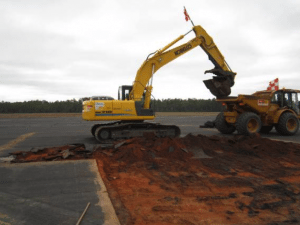
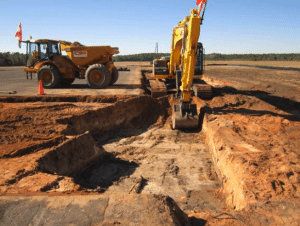
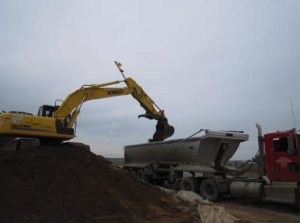
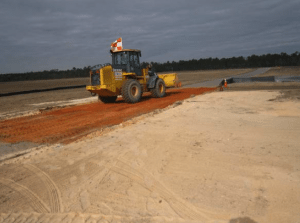
DNT set up grids at the point of impact and along the edges of the overrun, and conducted field screening using OVA/FID to determine the level of contamination. Samples were taken from other areas of the facility and submitted for laboratory analysis to establish a baseline for the OVA/FID readings. Maximum acceptable OVA/FID values were agreed with the Florida Department of Environmental Protection (FDEP) for the determination of contaminated soil. Grids that exceeded the maximum level were excavated and the contaminated soil stockpiled on site. The grids were excavated until the field screening values were below the maximum acceptable value, and then confirmation samples were taken for lab analysis.
The stockpiled soil was sampled and analyzed by the laboratory for characterization to determine the appropriate disposal option. Once disposal was approved, the material was transported to a landfill for disposal. The excavated areas were backfilled with clean soil from off-site, graded to match surrounding topography, and restored with sod. Two areas of the asphalt overrun required excavation to remove contaminated soil below the asphalt, as well as one section of an asphalt road adjacent to the runway. Those areas were restored with clean backfill and completed by patching the asphalt.
DNT was contracted to clean-up the debris and soil remediation of petroleum contaminated soil from the crash of a US Navy military helicopter in Texas. This project was considered an expedited effort and rapid mobilization and project startup were required.
Equipment and personnel were mobilized to the site to remove debris over a 4-5 acre area and to remove petroleum contaminated soil from the final crash area. The site was laid out into 25’ x 25’ grids and sampled for petroleum contamination using field instruments. Due to the possibility of MEC aboard the helicopter, the site was treated as potentially contaminated with MEC. All of the DNT personnel are 3R trained for remediation within a MEC site, and a MEC supervisor was present during the excavation activities. Once the contamination areas were determined, DNT excavated the material and arranged transportation to a local Subtitle D Landfill.
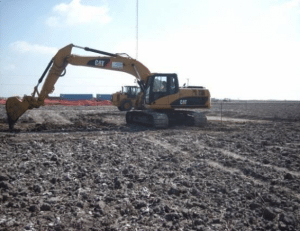
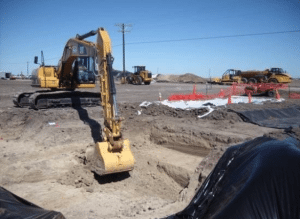

During the course of the project, DNT was responsible for site management, including securing the site and managing the personnel entry into the site. In addition to the typical reports generated from a remediation project, DNT managed correspondence with local, state and federal authorities.
Since the crash site was an agricultural area the clean-up standard had to insure that the petroleum contamination would not affect the crops being grown. DNT coordinated all of the cleanup efforts with CH2M HILL and the Navy as well as the land owner.
The area was excavated to a depth of fifteen feet until groundwater was encountered. The groundwater was pumped and containerized until the samples showed no signs of petroleum contamination. The excavation continued to depths of 28 feet after removal of the groundwater. Once the excavation was complete the area was sampled for confirmation and then backfilled using clean certified fill and topsoil. Sampling was performed with the excavator bucket at the bottom of the excavation to eliminate the need for personnel to enter the excavation. Since the crash site was in an agricultural field the topsoil was placed in the last three feet of the clean area. The petroleum contaminated soil was transported to an approved hazardous waste landfill for disposal.
DNT’s expedited efforts allowed the project to be completed ahead of the client’s target completion date and under the original budgeted amount for the contract.
DNT was contracted in 2013 by URS to perform the remediation of a four former firing ranges and one skeet shooting range at Beale Air Force Base (AFB) in Marysville, CA. The project involved the excavation of soil contaminated with lead from the bullets and lead shot used during the range activities, as well as potential polynuclear aromatic hydrocarbons (PAHs) from the clay target debris at the skeet range. The areas of contamination had been previously determined by sampling and analysis by others. Each site was divided into grids, and the grids were marked off for management of the contamination.
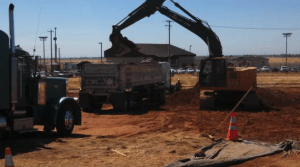

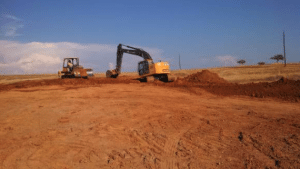
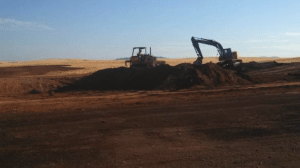
The areas were prepared by delineation of the grids, installation of erosion controls and boundary control markers to indicate the limits of excavation, and installation and/or improvement of access roads for truck travel. Control of site access and extent of equipment travel was carefully managed to prevent unnecessary travel into environmentally sensitive areas surrounding the excavation. Some of the grids with the highest levels of lead contamination were treated by mixing a reagent into the soil to stabilize the lead and prevent leaching from the soil prior to excavation.
The soil in each grid was excavated to the specified depth, and the removal of lead to below the action levels was confirmed in the field by XRF. Some areas within a given grid required over-excavation to remove the lead to acceptable levels. Confirmation samples were taken and submitted to the lab for analysis.
Contaminated soil was loaded into end dump trailers and transported to the approved landfill for disposal. The majority of the soil was transported and disposed as non-hazardous, with a small portion requiring classification as California-hazardous material due to higher lead concentrations.
Once all of the grids were confirmed clean, backfill with clean soil from off-site was performed. The backfill was graded to tie into the surrounding topography and promote positive drainage of the site. Once the grading was complete, erosion control wattles were installed at various intervals across the entire surface area of each site to control storm water flow and prevent erosion until vegetation was fully established. The areas were hydroseeded, and an electric fence was installed around each area to prevent cattle from entering the newly seeded areas. Approximately 12,000 tons of contaminated soil was removed from the sites for disposal.
DNT was contracted in 2012 by URS to perform the remediation of a former skeet shooting range at Maxwell Air Force Base (AFB) in Montgomery, AL. The project involved the excavation of soil contaminated with lead from the lead shot used during the active period of the skeet shooting range as well as potential polynuclear aromatic hydrocarbons (PAHs) from the clay target debris. The areas of contamination had been previously determined by sampling and analysis by others. The site had four distinct areas of contamination. Each area was divided into grids, and the grids were marked off for management of the contamination. The areas were prepared by clearing and grubbing, removal of several large trees, demolition of fencing and concrete, and delineation of the grids. Some of the grids with the highest levels of lead contamination were treated by mixing a reagent into the soil to stabilize the lead and prevent leaching from the soil.
The soil in each grid was excavated to the specified depth, and the removal of lead to below the action levels was confirmed in the field by XRF. Some areas within a given grid required over-excavation to remove the lead to acceptable levels. Confirmation samples were taken and submitted to the lab for analysis. The soil excavated from the grids where in-situ treatment with reagent had been performed was excavated and stockpiled. The material remained in stockpiles until results from the lab confirmed that the treatment was sufficient to prevent leaching of the lead. That material was then classified as non-hazardous for the purposes of transportation and disposal.

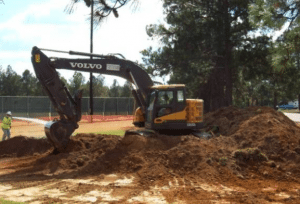
All of the material excavated from the site was loaded and transported to an approved disposal facility for non- hazardous waste. The grids were backfilled with clean fill delivered from an approved off-site source, with the final 4 – 6 inches filled with topsoil. The areas were graded to match the surrounding topography and promote positive drainage, and then sod was placed to complete the site restoration. A total of 4,500 tons of contaminated soil was removed from the site for disposal.
DNT was contracted by Black & Veatch, serving as the Prime Contractor for the EPA, to perform remediation activities at a lead contaminated Superfund site in Marianna, FL. The site was a former battery manufacturing and recycling facility. The contaminated area covered approximately 24 acres, where the soil contained high levels of lead and cadmium. The initial phase involved clearing and grubbing of the site.
In the second phase the soil was excavated and screened prior to treatment to remove large debris. The soil was then treated using a stabilization process where reagents were blended with the soil using a pugmill operation. This process blends two stabilization reagents into the soil and serves to bind the contaminants of concern in a matrix that prevents them from leaching from the soil.
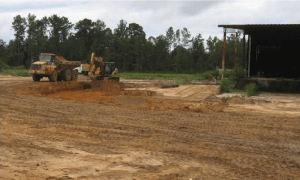
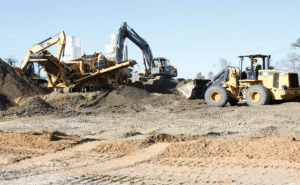
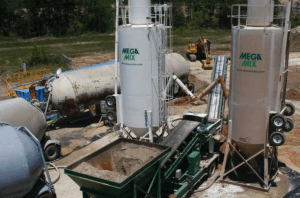
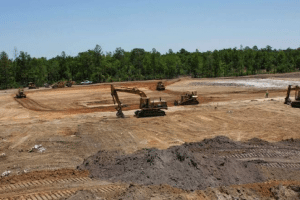
The stabilized soil was placed in a monolith disposal cell constructed on the site where it was solidified, providing containment for the contaminants of concern. The cell was finish graded and then covered with a GCL, topsoil, and sod. The excavated areas were backfilled with clean material obtained from borrow sites within the 180 acre property, graded to drain, and hydro-seeded.
Due to the nature of the former battery recycling operation and the type of contamination involved at this site, DNT was required to make adjustments in the operation of the remediation effort in order to pursue areas where it was obvious during the excavation that additional contamination existed. The former operation of this facility resulted in a large amount of waste material from the recycling of the batteries (plastic chips, battery parts, spent acid, etc.), which was disposed at the site in various unmarked locations. During the excavation operations, areas were uncovered where there was visual observation of additional waste and contaminated soil. Excavations were continued in those areas to remove the obvious waste and contamination. DNT managed the over-excavations and subsequent treatment closely and efficiently, allowing completion of the primary objectives of the project within the client’s budget and schedule.
One area of contamination at the site was in a wetland on property adjacent to the site entrance where contamination had been carried downstream in run-off water from the site and deposited in the soil. The soil from the wetland area was excavated taking precautions to minimize the disruption of the natural environment by utilizing smaller equipment and transferring contaminated soil to more stable ground adjacent to the wetland area prior to loading for transport. The wetland area was restored by planting additional native trees and restoring ground cover consistent with the natural habitat.
DNT has performed work on seven different contracts that are part of the EPA Region 6 Tar Creek Superfund OU4 Site in Ottawa County, Oklahoma. DNT was contracted by CH2M Hill as the Remedial Action Contractor (RAC) for EPA Region 6 to perform these contracts for remediation of lead mining waste. The Site is part of a former lead and zinc mining area known as the Tri-State Mining District, which includes portions of northeastern Oklahoma, southeastern Kansas, and southwestern Missouri. The Site includes all of the area in northern Ottawa County where lead and zinc mining operations were conducted (approximately 40 square miles), as well as communities within the county that are outside of the mining area but are contaminated with mining waste. The mining waste is present in the form of chat (finely crushed rock from the lead recovery process), development rock from the digging of mines, and contaminated soil around and beneath the chat and rock. The levels of heavy metal contamination in the mining waste exceed the remediation goals for the site.
The first contract was the remediation of residential properties in the towns of
Picher and Cardin, OK. DNT removed contaminated soil and chat from the properties and replaced it with clean backfill and sod. The contaminated soil and chat
were transported to a central repository established at the site for the consolidation of materials from the entire Superfund site. This consolidation area, known as the repository, was designed to provide for a securely controlled area for the management of these wastes to eliminate the exposure hazards to the public.
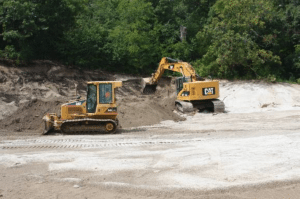
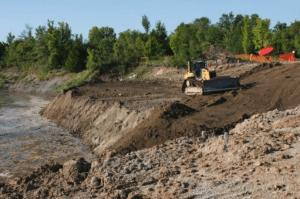
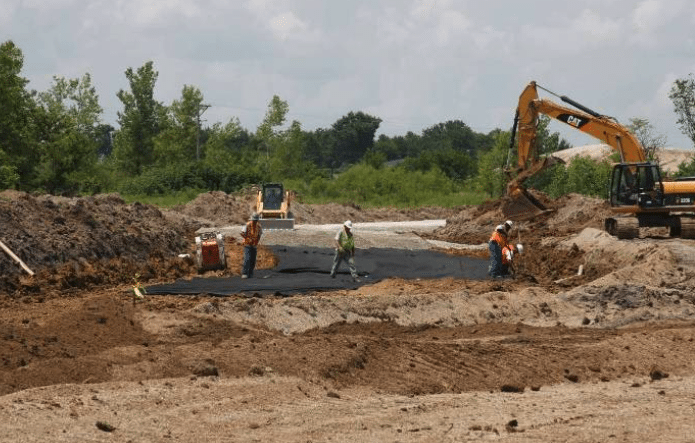
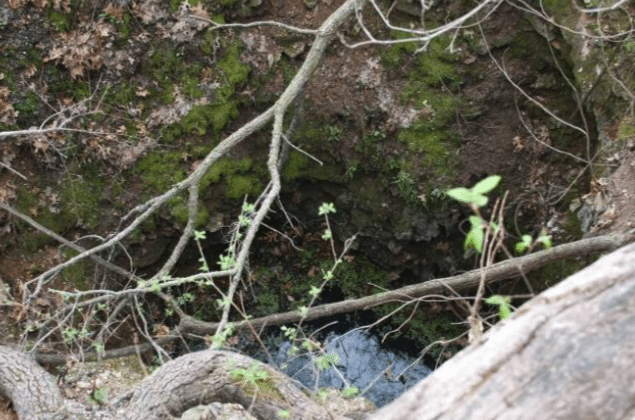
The next two contracts involved the removal of large chat piles and chat bases followed by excavation of the contaminated soil beneath the chat. The contaminated material was transported to the central repository for disposal. Several mine shafts were also filled and capped on these properties. The area was graded to drain and seeded.
The fourth contract involved the excavation and consolidation of chat, development rock and contaminated soils into a large (1.5 acre) subsidence feature. Access roads were constructed so that additional source material could be brought into the site for consolidation into the subsidence. Once filled, the subsidence was allowed to settle and then graded, capped with clean soil and seeded. The remainder of the site was graded to promote drainage and seeded.
The fifth contract involved the removal of two large chat piles and the surrounding chat bases from an agricultural area followed by excavation of the contaminated soil beneath the chat. Several mine shafts and cased borings were filled and capped on the property, and the site was graded to drain and seeded.
The sixth contract involved removal of source materials from 4 distinctly separate locations. The largest site also required the filling and capping with clean fill and topsoil of a subsidence feature. One of the sites required a pond to be drained to remove source material prior to site restoration.

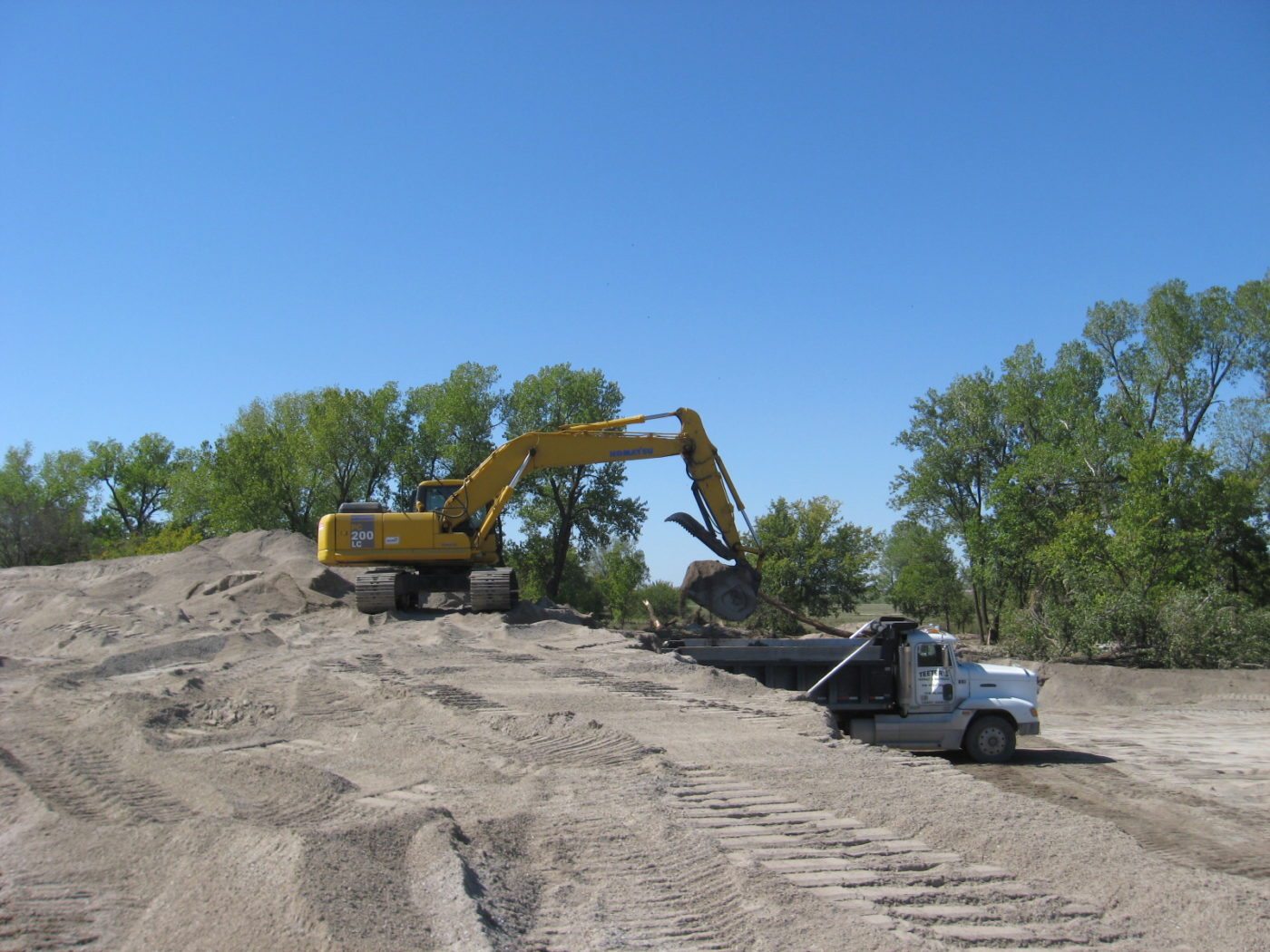
The seventh contract awarded to DNT was for the operations and maintenance of the central repository for the Superfund site. DNT is responsible for receiving contaminated material into the repository and placement of the material into the working face of the repository. The material is graded and compacted to match the design specifications for the repository. Storm water management systems are installed in the repository stockpile at prescribed elevations as the pile is constructed. The daily operations can range from accommodation of a few trucks to over 400 trucks hauling material into the repository. Operations include traffic control, haul truck management, dust control, erosion control, storm water management, and material management. In addition to the daily and routine tasks, DNT is responsible for the construction of the base course of material for the next phase of expansion of the repository, which includes clearing and grubbing, surface preparation for stability, installation of geotextile, and placement of a stable initial portion of material to provide a strong base. DNT also operates the decontamination facility for the haul trucks delivering material to the repository.
DNT was contracted to perform the installation of groundwater treatment system at this Air Force site. The site, known as Site SS-274, was located at Duke Field, a part of Eglin AFB in Crestview, FL. During active use in the late 1950s, Site SS-274 (formerly designated as Site FT-27) consisted of 2 circular burn pits approximately 250 feet apart. The burn pits were used for fire training and disposal of waste fuels, oils and solvents. Contamination remaining in the soil has migrated into the groundwater. The remediation technology selected for treatment of the groundwater was Aquifer Air Sparging (AAS), Bioventing (BV), Thermally Enhanced Soil Sparging (TESS) and Soil Vapor Extraction (SVE) with offgas treatment.
DNT was contracted to install the field piping at the site, to connect the extraction wells with the treatment systems, and to assist with start-up of the system. The SOW included:

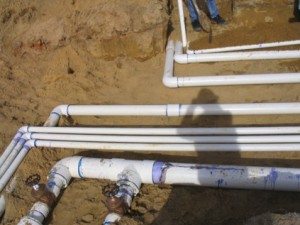
DNT was contracted to perform the installation and O&M of a groundwater treatment system at Bronson Field Site 1159. The site was part of NAS Pensacola, and was used as an active airfield from 1942 through 1950. Contamination at the site was believed to have occurred from leaks in USTs and associated pipelines for diesel fuel and AVGAS near Building 1159. Groundwater at Site 1159 has been monitored since 1996 and contains concentrations of COCs (benzene, toluene, ethylbenzene, total xylenes, TRPH and lead) above respective State of Florida criteria. A remediation system and associated field piping was installed at Site 1159 to treat the groundwater contamination.
DNT was contracted to install the remediation system and field piping at the site and perform O&M of this system and 3 others at the base. The SOW included:
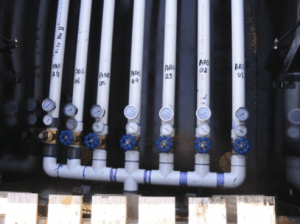
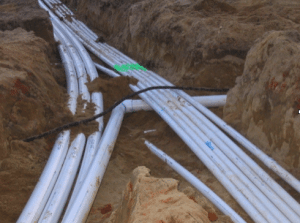
DNT was contracted by Arcadis to perform the construction and installation of a Direct Groundwater Recirculation system for the Southwest Landfill (LF-03) site at Moody AFB. The LF-03 site encompasses 56 acres and consists of unimproved, piney woods. The landfill was constructed as a trench and fill style landfill and was active from 1955 to 1972. The groundwater at the site is impacted with dissolved-phase chlorinated solvents and hydrocarbon compounds.
DNT developed all required plans (Work Plan, HASP, JHAs) prior to mobilization to the site. Site preparation was performed, which included the installation of erosion controls, clearing and grubbing of vegetation and trees, widening and improvement of the existing access road, and utility locate verification.
DNT excavated trenches for the installation of three legs of the treatment system to enable connection of 21 extraction and injection wells. DNT installed HDPE pipe from each of the wells to the treatment system enclosure. The system complete in enclosure was supplied to the site by others. DNT constructed concrete footers and a pad for placement of the enclosure, and received, set and anchored the enclosure once it arrived at the site. Well heads, instrumentation and down-well pumps were installed at each of the wells and connected to the conveyance piping. The piping was connected to the manifold at the enclosure end. In addition, conduit was installed in the trenches to provide electrical power and instrument control cabling to the wells. The wiring was installed in the conduit and connected at the well head and enclosure ends to the appropriate junctions. Electrical service was installed, including a transformer, to provide power to the system enclosure sufficient to operate all components.
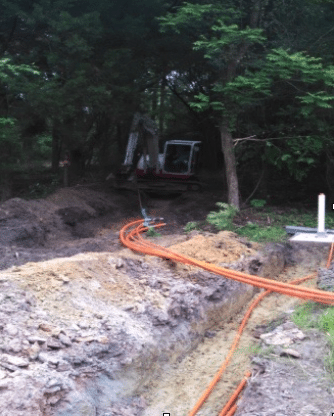
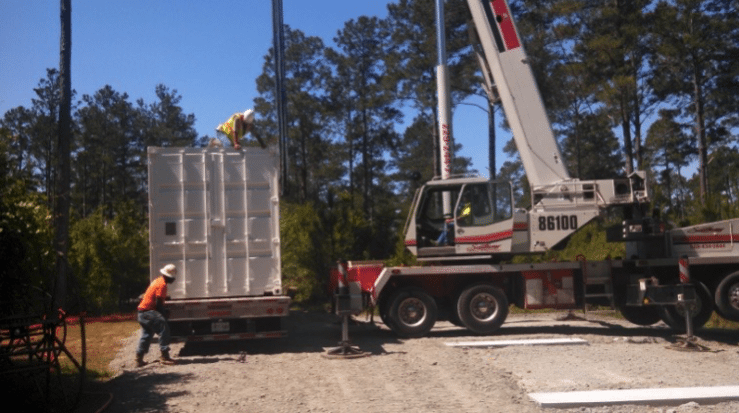
The piping was pressure tested and made ready for start-up. DNT supported the start-up of the system with personnel available for troubleshooting and/or repairs. The disturbed areas were backfilled, graded and seeded to complete site restoration.
DNT was contracted to remediate an area of petroleum contaminated soil located in the vicinity of a previously removed Underground Storage Tank (UST). The area was in the center of a site being developed as part of the Marine Air Support Squadron Complex, and where future construction activities were likely to occur.
The site had been previously characterized through sampling and analysis by others in order to delineate the boundaries of the contamination. DNT excavated the contaminated soil within the boundaries, working with the on-site engineer that conducted real-time testing of the excavation side walls and floors to determine the need for any over-excavation and ensure that all of the contamination was removed. Excavation to 12 feet below ground surface at the center of the site was performed. Excavated material was loaded into trucks for transport to and approved off-site disposal facility.
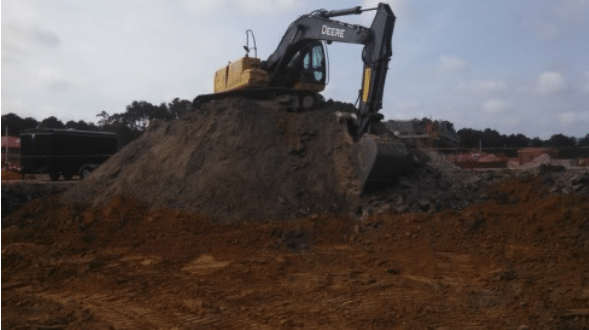
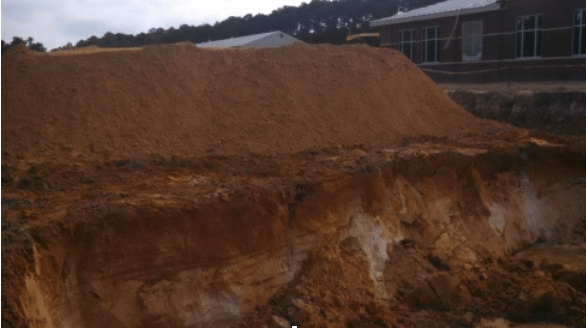
DNT provided backfill to the site and placed and compacted the fill material in the excavation. The excavated area was brought back to the original grade and tied into the surrounding topography. A parking area is planned for the site, so it will be finished by others at the appropriate time during the construction project. Approximately 3,500 tons of contaminated material was removed and disposed from the site.
DNT has removed and properly closed several USTs around the campus of Berry College in Rome, GA. Operating under a Blanket Purchase Agreement, DNT has provided environmental services to the college for many years, including the UST removal and closure work. USTs of various sizes have been decommissioned by the college, and DNT has been tasked with performing the appropriate task, whether closure or removal. The USTs were previously used for a variety of operations from diesel and gasoline storage to heating oil. DNT conducted the tank removals and closures in accordance with the Georgia EPD requirements for USTs, including the preparation and filing of tank closure reports.
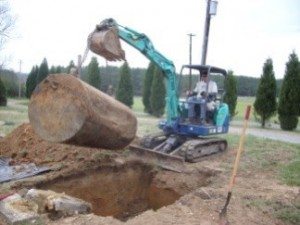
DNT teamed with MECX to perform the removal of three USTs at three National Cemetery locations near Richmond, VA for the Department of Veterans Affairs.
The three National Cemeteries located in Richmond, Sandston, and Mechanicsburg, Virginia all contained one UST each, previously utilized for fuel storage that were no longer in use. The client wished to have the USTs removed with no damage to the surrounding cemetery features or disruptions to services conducted at the cemetery.

DNT provided the labor, materials and equipment to excavate each of the USTs, including the associated piping. All free liquid was removed from the USTs and they were cleaned sufficient to meet the EPA disposal requirements. The soil surrounding the USTs was excavated to remove any petroleum impacted material. The excavated areas were backfilled with clean off-site fill material, compacted and graded to match the surrounding terrain. The disturbed areas were seed for re-vegetation. The USTs were cleaned and modified according to disposal requirements to render them unusable and were transported to an approved off-site disposal facility.
To learn more about our wide range of capabilities, please contact us or call 770-739-5600.